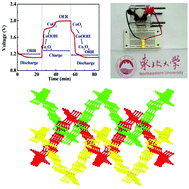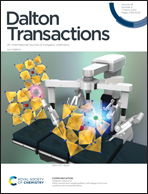A Co-MOF-derived oxygen-vacancy-rich Co3O4-based composite as a cathode material for hybrid Zn batteries†
Abstract
Through the integration of Zn-Co3O4 and Zn-air batteries at the cell level, a hybrid battery was assembled, which possessed a higher voltage and power density than a common Zn-air battery. In this hybrid battery, the cathode material is composed of oxygen-vacancy-rich Co3O4−x and N, S-co-doped carbon derived from a metal–organic framework; a Zn plate acts as the anode. With a current of 1 A g−1, the specific capacity of the cathode material achieves 144 mA h g−1. A four-electron process dominates the oxygen reduction reaction of the cathode material with a half wave potential of 0.78 V. In the oxygen evolution reaction, the η10 potential of the cathode material is merely 365 mV. When discharged at 1 mA cm−2, the hybrid Zn battery shows two discharge plateaus at 1.75 V and 1.11 V. Its specific capacity and energy density reach 711 mA h g−1 and 810 W h kg−1, respectively. This battery also inherits superior power density from the Zn-Co3O4 battery. Its peak power density occurs at 43.6 mW cm−2, and this value is obviously higher than that of the Zn-air battery built from the same cathode material. The hybrid battery also exhibits excellent stability with a capacity and charge–discharge voltage that are well maintained after long time periods. This study integrates two distinct batteries into one power source to develop a hybrid Zn battery, which possesses high voltage, specific capacity and superior power and energy densities.



 Please wait while we load your content...
Please wait while we load your content...